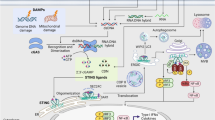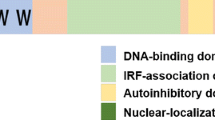Abstract
Recent work has highlighted a role for PDK1 in adaptive immunity, however its contribution to innate immunity has not been addressed. We have investigated the role of PKB and PDK1 in IL-1β-induced NF-κB activation. Over-expression of either in HCT 116 and HEK 293T cells, effected a reproducible NF-κB activation. This was validated in a one-hybrid assay utilizing Gal4-RelA and Gal4-luciferase assay. N-tosyl phenylalanyl chloromethyl ketone (TPCK), wortmannin and Ly294002 inhibited IL-1β-induced NF-κB activation in both systems indicating involvement of the PI3K axis in this response. p65 (Rel A) Ser536 phosphorylation was not affected by the PI3K inhibitors but was dose-dependently attenuated by TPCK. Evaluation of IKK-associated activity using GST-p65 substrate phosphorylation in immune complex assays, revealed that whilst TPCK attenuated this, neither of the PI3K inhibitors had any effect. Furthermore whilst TPCK inhibited IL-1β-induced p65 DNA binding, this was not apparent with either of wortmannin or Ly294002. Similarly, over-expression of PDK1 but not PKB resulted in promotion of p65 DNA binding. Using a p65-S536A reporter construct, we found inhibition of only PDK1 over-expression-induced, but not PKB over-expression-induced NF-κB activation. This was supported using biochemical analysis in which immunoprecipitated IKKγ from IL-1β-activated cells was unable to phosphorylate a p65-S536A substrate, confirming this as the dominant IKK-dependent site. In further support of a dissociated response, we observed an attenuation of the Ser177/181 IKK phosphorylation by TPCK but not in response to PI3K inhibition. Our data reveals for the first time that PDK1 and PKB may differentially activate NF-κB, and that TPCK may subserve a useful anti-inflammatory function by inhibiting IKKβ.








Similar content being viewed by others
Abbreviations
- IL-1β:
-
interleukin 1 beta
- IL-1R:
-
interleukin 1 receptor
- NF-κB:
-
nuclear factor kappa B
- MyD88:
-
myeloid differentiation primary response gene 88
- IRAK 1:
-
IL-1 receptor associated kinase 1
- Traf 6:
-
TNF-receptor associated factor 6
- IKK:
-
I kappa kinase
- PKB:
-
protein kinase B
- PDK:
-
phosphoinositide-dependent kinase 1
- PI3K:
-
phosphatidylinositol 3 kinase
- ILK:
-
integrin-linked kinase
- IECs:
-
intestinal epithelial cells
- CBP:
-
CREB binding protein
- TAK1:
-
TGFβ-activated kinase
- TAD:
-
transactivation domain
References
Akira S, Takeda K, Kaisho T (2001) Toll-like receptors: critical proteins linking innate and acquired immunity. Nat Immunol 2:675–680
Cario E, Rosenberg IM, Brandwein SL, Beck PL, Reinecker HC, Podolsky DK (2000) Lipopolysaccharide activates distinct signaling pathways in intestinal epithelial cell lines expressing Toll-like receptors. J Immunol 164:966–972
Abreu MT, Vora P, Faure E, Thomas LS, Arnold ET, Arditi M (2001) Decreased expression of Toll-like receptor-4 and MD-2 correlates with intestinal epithelial cell protection against dysregulated proinflammatory gene expression in response to bacterial lipopolysaccharide. J Immunol 167:1609–1616
Jobin C, Sartor RB (2000) The I kappa B/NF-kappa B system: a key determinant of mucosal inflammation and protection. Am J Physiol Cell Physiol 278:C451–C462
Dwinell MB, Lugering N, Eckmann L, Kagnoff MF (2001) Regulated production of interferon-inducible T-cell chemoattractants by human intestinal epithelial cells. Gastroenterology 120:49–59
Yang SK, Eckmann L, Panja A, Kagnoff MF (1997) Differential and regulated expression of C-X-C, C-C, and C-chemokines by human colon epithelial cells. Gastroenterology 113:1214–1223
Li Q, Verma IM (2002) NF-kappaB regulation in the immune system. Nat Rev Immunol 2:725–734
Chen LF, Mu Y, Greene WC (2002) Acetylation of RelA at discrete sites regulates distinct nuclear functions of NF-kappaB. EMBO J 21:6539–6548
Zhong H, May MJ, Jimi E, Ghosh S (2002) The phosphorylation status of nuclear NF-kappaB determines its association with CBP/p300 or HDAC-1. Mol Cell 9:625–636
Okazaki T, Sakon S, Sasazuki T, Sakurai H, Doi T, Yagita H, Okumura K, Nakano H (2003) Phosphorylation of serine 276 is essential for p65 NF-kappaB subunit-dependent cellular responses. Biochem Biophys Res Commun 300:807–812
Zhong H, Voll RE, Ghosh S (1998) Phosphorylation of NF-kappa B p65 by PKA stimulates transcriptional activity by promoting a novel bivalent interaction with the coactivator CBP/p300. Mol Cell 1:661–671
Vermeulen L, De Wilde G, Van Damme P, Vanden Berghe W, Haegeman G (2003) Transcriptional activation of the NF-kappaB p65 subunit by mitogen- and stress-activated protein kinase-1 (MSK1). EMBO J 22:1313–1324
Duran A, Diaz-Meco MT, Moscat J (2003) Essential role of RelA Ser311 phosphorylation by zetaPKC in NF-kappaB transcriptional activation. EMBO J 22:3910–3918
Bird TA, Schooley K, Dower SK, Hagen H, Virca GD (1997) Activation of nuclear transcription factor NF-kappaB by interleukin-1 is accompanied by casein kinase II-mediated phosphorylation of the p65 subunit. J Biol Chem 272:32606–32612
Bae JS, Jang MK, Hong S, An WG, Choi YH, Kim HD, Cheong J (2003) Phosphorylation of NF-kappa B by calmodulin-dependent kinase IV activates anti-apoptotic gene expression. Biochem Biophys Res Commun 305:1094–1098
Sakurai H, Suzuki S, Kawasaki N, Nakano H, Okazaki T, Chino A, Doi T, Saiki I (2003) Tumor necrosis factor-α-induced IKK phosphorylation of NF-κB p65 on serine 536 is mediated through the TRAF2, TRAF5, and TAK1 signaling pathway. J Biol Chem 278:36916–36923
Haller D, Russo MP, Sartor RB, Jobin C (2002) IKK beta and phosphatidylinositol 3-kinase/Akt participate in non-pathogenic gram-negative enteric bacteria-induced RelA phosphorylation and NF-kappa B activation in both primary and intestinal epithelial cell lines. J Biol Chem 277:38168–38178
Madrid LV, Mayo MW, Reuther JY, Baldwin AS Jr (2001) Akt stimulates the transactivation potential of the RelA/p65 Subunit of NF-kappa B through utilization of the Ikappa B kinase and activation of the mitogen-activated protein kinase p38. J Biol Chem 276:18934–18940
Sakurai H, Chiba H, Miyoshi H, Sugita T, Toriumi W (1999) IkappaB kinases phosphorylate NF-kappaB p65 subunit on serine 536 in the transactivation domain. J Biol Chem 274:30353–30356
Sizemore N, Leung S, Stark GR (1999) Activation of phosphatidylinositol 3-kinase in response to interleukin-1 leads to phosphorylation and activation of the NF-kappaB p65/RelA subunit. Mol Cell Biol 19:4798–4805
Madrid LV, Wang CY, Guttridge DC, Schottelius AJ, Baldwin AS, Mayo MW (2000) Akt suppresses apoptosis by stimulating the transactivation potential of the RelA/p65 subunit of NF-kappaB. Mol Cell Biol 20:1626–1638
Anest V, Hanson JL, Cogswell PC, Steinbrecher KA, Strahl BD, Baldwin AS (2003) A nucleosomal function for IkappaB kinase-alpha in NF-kappaB-dependent gene expression. Nature 423:659–663
Yamamoto Y, Verma UN, Prajapati S, Kwak YT, Gaynor RB (2003) Histone H3 phosphorylation by IKK-alpha is critical for cytokine-induced gene expression. Nature 423:655–659
Delhase M, Hayakawa M, Chen Y, Karin M (1999) Positive and negative regulation of IkappaB kinase activity through IKKbeta subunit phosphorylation. Science 284:309–313
Takaesu G, Surabhi RM, Park KJ, Ninomiya-Tsuji J, Matsumoto K, Gaynor RB (2003) TAK1 is critical for IkappaB kinase-mediated activation of the NF-kappaB pathway. J Mol Biol 326:105–115
Yang J, Lin Y, Guo Z, Cheng J, Huang J, Deng L, Liao W, Chen Z, Liu Z, Su B (2001) The essential role of MEKK3 in TNF-induced NF-kappaB activation. Nat Immunol 2:620–624
Leitges M, Sanz L, Martin P, Duran A, Braun U, Garcia JF, Camacho F, Diaz-Meco MT, Rennert PD, Moscat J (2001) Targeted disruption of the zetaPKC gene results in the impairment of the NF-kappaB pathway. Mol Cell 8:771–780
Zandi E, Chen Y, Karin M (1998) Direct phosphorylation of IkappaB by IKKalpha and IKKbeta: discrimination between free and NF-kappaB-bound substrate. Science 281:1360–1363
Lee FS, Peters RT, Dang LC, Maniatis T (1998) MEKK1 activates both IkappaB kinase alpha and IkappaB kinase beta. Proc Natl Acad Sci USA 95:9319–9324
Zandi E, Rothwarf DM, Delhase M, Hayakawa M, Karin M (1997) The IkappaB kinase complex (IKK) contains two kinase subunits, IKKalpha and IKKbeta, necessary for IkappaB phosphorylation and NF-kappaB activation. Cell 91:243–252
Woronicz JD, Gao X, Cao Z, Rothe M, Goeddel DV (1997) IkappaB kinase-beta: NF-kappaB activation and complex formation with IkappaB kinase-alpha and NIK. Science 278:866–869
Mercurio F, Zhu H, Murray BW, Shevchenko A, Bennett BL, Li J, Young DB, Barbosa M, Mann M, Manning A, Rao A (1997) IKK-1 and IKK-2: cytokine-activated IkappaB kinases essential for NF-kappaB activation. Science 278:860–866
Scheid MP, Woodgett JR (2003) Unravelling the activation mechanisms of protein kinase B/Akt. FEBS Lett 546:108–112
Romashkova JA, Makarov SS (1999) NF-kappaB is a target of AKT in anti-apoptotic PDGF signalling. Nature 401:86–90
Ozes ON, Mayo LD, Gustin JA, Pfeffer SR, Pfeffer LM, Donner DB (1999) NF-kappaB activation by tumour necrosis factor requires the Akt serine-threonine kinase. Nature 401:82–85
Storz P, Toker A (2002) 3′-phosphoinositide-dependent kinase-1 (PDK-1) in PI 3-kinase signaling. Front Biosci 7:d886–d902
Sato S, Fujita N, Tsuruo T (2002) Regulation of kinase activity of 3-phosphoinositide-dependent protein kinase-1 by binding to 14-3-3. J Biol Chem 277:39360–39367
Fujita N, Sato S, Ishida A, Tsuruo T (2002) Involvement of Hsp90 in signaling and stability of 3-phosphoinositide-dependent kinase-1. J Biol Chem 277:10346–10353
Kim DW, Hwang JH, Suh JM, Kim H, Song JH, Hwang ES, Hwang IY, Park KC, Chung HK, Kim JM, Park J, Hemmings BA, Shong M (2003) RET/PTC (rearranged in transformation/papillary thyroid carcinomas) tyrosine kinase phosphorylates and activates phosphoinositide-dependent kinase 1 (PDK1): an alternative phosphatidylinositol 3-kinase-independent pathway to activate PDK1. Mol Endocrinol 17:1382–1394
Horton RM (1995) PCR-mediated recombination and mutagenesis. SOEing together tailor-made genes. Mol Biotechnol 3:93–99
Davies SP, Reddy H, Caivano M, Cohen P (2000) Specificity and mechanism of action of some commonly used protein kinase inhibitors. Biochem J 351:95–105
Ballif BA, Shimamura A, Pae E, Blenis J (2001) Disruption of 3-phosphoinositide-dependent kinase 1 (PDK1) signaling by the anti-tumorigenic and anti-proliferative agent n-alpha-tosyl-l-phenylalanyl chloromethyl ketone. J Biol Chem 276:12466–12475
Delhase M, Li N, Karin M (2000) Kinase regulation in inflammatory response. Nature 406:367–368
Tanaka H, Fujita N, Tsuruo T (2005) 3-Phosphoinositide-dependent protein kinase 1-mediated IκB kinase (IKKB) phosphorylation activates NF-κB signaling. J Biol Chem 280:40965–40973
Schoellmann G (1962) Biochemistry 2:252–255
Troll W, Klassen A, Janoff A (1970) Tumorigenesis in mouse skin: inhibition by synthetic inhibitors of proteases. Science 169:1211–1213
Slaga TJ, Klein-Szanto AJ, Fischer SM, Weeks CE, Nelson K, Major S (1980) Studies on mechanism of action of anti-tumor-promoting agents: their specificity in two-stage promotion. Proc Natl Acad Sci USA 77:2251–2254
Grammer TC, Blenis J (1996) The serine protease inhibitors, tosylphenylalanine chloromethyl ketone and tosyllysine chloromethyl ketone, potently inhibit pp70s6k activation. J Biol Chem 271:23650–23652
Wu M, Lee H, Bellas RE, Schauer SL, Arsura M, Katz D, FitzGerald MJ, Rothstein TL, Sherr DH, Sonenshine GE (1996) Inhibition of NF-kappaB/Rel induces apoptosis of murine B cells. EMBO J 15:4682–4690
Tang ED, Inohara N, Wang CY, Nunez G, Guan KL (2003) Roles for homotypic interactions and transautophosphorylation in IκB Kinase (IKKβ) activation. J Biol Chem 278:38566–38570
Chen G, Cao P, Goeddel DV (2002) TNF-induced recruitment and activation of the IKK complex require Cdc37 and Hsp90. Mol Cell 9:401–410
Hoeflich KP, Luo J, Rubie EA, Tsao MS, Jin O, Woodgett JR (2000) Requirement for glycogen synthase kinase-3beta in cell survival and NF-kappaB activation. Nature 406:86–90
Buss H, Dorrie A, Schmitz ML, Frank R, Livingstone M, Resch K, Kracht M (2004) Phosphorylation of serine 468 by GSK-3beta negatively regulates basal p65 NF-kappaB activity. J Biol Chem 279:49571–49574
Lee KY, D’Acquisto F, Hayden MS, Shim JH, Ghosh S (2005) PDK1 nucleates T cell receptor-induced signaling complex for NF-kappaB activation. Science 308:114–118
Author information
Authors and Affiliations
Corresponding author
Additional information
This study was supported in part by grants from the Crohn’s and Colitis Foundation of Canada (BS) and the Canadian Society for Intestinal Research (BS) and funds from the Geraldine Dow Foundation to B. S. K.P. was supported by a Michael Smith Graduate Studentship. The costs of publication of this article were defrayed in part by the payment of page charges. This article must therefore be hereby marked, “advertisement” in accordance with 18 U.S.C. Section 1734 solely to indicate this fact.
Rights and permissions
About this article
Cite this article
Parhar, K., Eivemark, S., Assi, K. et al. Investigation of interleukin 1β-mediated regulation of NF-κB activation in colonic cells reveals divergence between PKB and PDK-transduced events. Mol Cell Biochem 300, 113–127 (2007). https://doi.org/10.1007/s11010-006-9375-4
Received:
Accepted:
Published:
Issue Date:
DOI: https://doi.org/10.1007/s11010-006-9375-4




